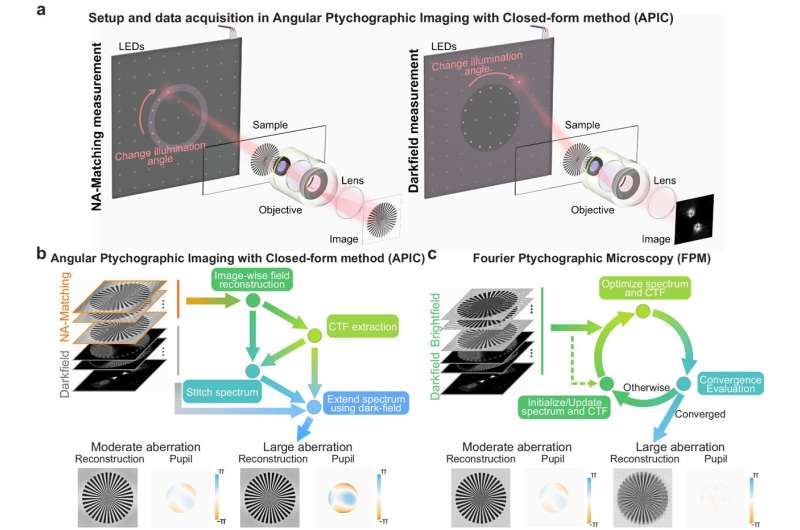
Concept of Angular Ptychographic Imaging with Closed Form Method (APIC) and comparison between APIC reconstruction process and Fourier Ptychographic Microscopy (FPM). Credit : Natural communications (2024). DOI: 10.1038/s41467-024-49126-y
For hundreds of years, the clarity and magnification of microscopes were limited by the physical properties of their optical lenses. Microscope manufacturers pushed these limits by building increasingly complex and expensive stacks of lens elements. Yet scientists had to choose between high resolution and a small field of view, or low resolution and a large field of view.
In 2013, a team of Caltech engineers introduced a microscopy technique called FPM (Fourier ptychographic microscopy). This technology marked the advent of computational microscopy, the use of techniques that combine the detection of conventional microscopes with computer algorithms that process the detected information in new ways to create deeper, sharper images covering larger areas. FPM has since been widely adopted for its ability to acquire high-resolution images of samples while maintaining a wide field of view using relatively inexpensive equipment.
Now, the same lab has developed a new method that can surpass FPM in its ability to obtain images free of blur or distortion, even by taking fewer measurements. The new technique, described in a paper in the journal Nature Communicationscould lead to advances in areas such as biomedical imaging, digital pathology and drug screening.
The new method, called APIC (for Angular Ptychographic Imaging with Closed-form method), presents all the advantages of FPM without what could be described as its greatest weakness: namely that to arrive at a final image, the FPM algorithm relies on starting at one or more best estimates, then adjusting bit by bit to arrive at its “optimal” solution, which is not always faithful to the original picture.
Led by Changhuei Yang, the Thomas G. Myers Professor of Electrical, Bioengineering, and Medical Engineering and a research scientist at the Heritage Medical Research Institute, the Caltech team realized that it was possible to eliminate this iterative nature of the algorithm.
Rather than relying on trial and error to try to find a solution, APIC solves a linear equation, providing details about the aberrations or distortions introduced by a microscope’s optical system. Once the aberrations are known, the system can correct for them, operating as if it were ideal and producing clear images covering wide fields of view.
“We are able to solve the high-resolution complex field problem in a closed way because we now have a deeper understanding of what a microscope captures, what we already know, and what we really need to understand, so that we don’t need iteration,” says Ruizhi Cao, co-lead author of the paper, a former graduate student in Yang’s lab and now a postdoctoral researcher at UC Berkeley. “This way we can virtually guarantee that we see the true final details of a sample. »
As with FPM, the new method measures not only the intensity of light seen under a microscope, but also an important property of light called “phase,” which relates to how far the light travels. This property goes unnoticed by the naked eye but contains very useful information for correcting aberrations.
To resolve this phase information, FPM relied on a trial-and-error method, says Cheng Shen, co-senior author of the APIC paper, who also did the work in FPM’s lab. Yang and is now a computer vision algorithm engineer at Apple.
“We have proven that our method gives you an analytical solution in a much simpler way. It is faster, more accurate, and leverages deep information about the optical system,” says Shen.
Beyond eliminating the iterative nature of the phase resolution algorithm, the new technique also allows researchers to gather clear images across a wide field of view without repeatedly refocusing the microscope. With FPM, if the sample height varied by even a few tens of microns from section to section, the person operating the microscope would have to refocus to make the algorithm work.
Since these computational microscopy techniques frequently involve stitching together more than 100 lower resolution images to piece together a larger field of view, this means that APIC can speed up the process and prevent the possible introduction of human error to many steps.
“We developed a framework to correct aberrations and improve resolution,” Cao explains. “Both of these capabilities may prove potentially fruitful for a broader range of imaging systems.” »
Yang says the development of the APIC is key to the broader scope his lab is currently working on to optimize image data input for artificial intelligence (AI) applications.
“Recently, my lab showed that AI can outperform expert pathologists in predicting metastatic progression from single histopathology slides of lung cancer patients,” Yang says. “This prediction ability is highly dependent on consistently sharp, high-quality microscopy images, which APIC is particularly suited for.”
More information:
Ruizhi Cao et al, High-resolution and large field-of-view label-free imaging via aberration-corrected closed-form complex field reconstruction, Natural communications (2024). DOI: 10.1038/s41467-024-49126-y
Provided by California Institute of Technology
Quote: New computer microscopy technique offers more direct path to crisp images (June 28, 2024) Retrieved June 29, 2024 from https://phys.org/news/2024-06-microscopy-technique-route-crisp-images.html
This document is subject to copyright. Apart from any fair dealing for the purpose of private study or research, no part may be reproduced without written permission. The content is provided for information purposes only.